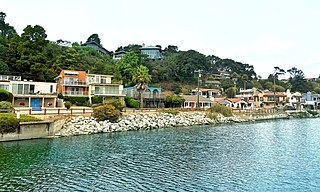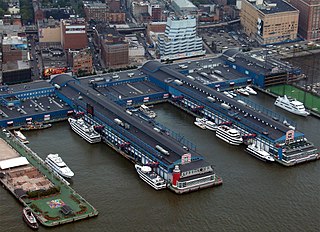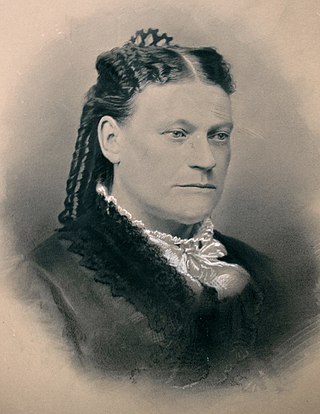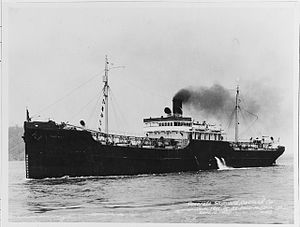
Aptos is an unincorporated town in Santa Cruz County, California. The town is made up of several small villages, which together form Aptos: Aptos Hills-Larkin Valley, Aptos Village, Cabrillo, Seacliff, Rio del Mar, and Seascape. Together, they have a combined population of 24,402.

Rio del Mar is an unincorporated village in Santa Cruz County, California. Rio del Mar is one of several small villages that form the unincorporated community of Aptos, California. Its population was 9,128 as of the 2020 United States census.

A pier is a raised structure that rises above a body of water and usually juts out from its shore, typically supported by piles or pillars, and provides above-water access to offshore areas. Frequent pier uses include fishing, boat docking and access for both passengers and cargo, and oceanside recreation. Bridges, buildings, and walkways may all be supported by architectural piers. Their open structure allows tides and currents to flow relatively unhindered, whereas the more solid foundations of a quay or the closely spaced piles of a wharf can act as a breakwater, and are consequently more liable to silting. Piers can range in size and complexity from a simple lightweight wooden structure to major structures extended over 1,600 m (5,200 ft). In American English, a pier may be synonymous with a dock.
Concrete ships are built of steel and ferrocement instead of more traditional materials, such as steel or wood. The advantage of ferrocement construction is that materials are cheap and readily available, while the disadvantages are that construction labor costs are high, as are operating costs. During the late 19th century, there were concrete river barges in Europe, and during both World War I and World War II, steel shortages led the US military to order the construction of small fleets of ocean-going concrete ships, the largest of which was the SS Selma. United States Maritime Administration (MARAD) designation for concrete ships-barges was Type B ship. Few concrete ships were completed in time to see wartime service during World War I, but during 1944 and 1945, concrete ships and barges were used to support U.S. and British invasions in Europe and the Pacific. Since the late 1930s, there have also been ferrocement pleasure boats.

Seacliff State Beach is a state beach park on Monterey Bay, in the town of Aptos, Santa Cruz County, California. It is located off Highway 1 on State Park Drive, about 5 miles (8 km) south of Santa Cruz,. The beach is most known for the concrete ship SS Palo Alto lying in the water. North of Seacliff State Beach is New Brighton State Beach.

Santa Monica Bay is a bight of the Pacific Ocean in Southern California, United States. Its boundaries are slightly ambiguous, but it is generally considered to be the part of the Pacific within an imaginary line drawn between Point Dume, in Malibu, and the Palos Verdes Peninsula. Its eastern shore forms the western boundary of the Los Angeles Westside and South Bay regions. Although it was fed by the Los Angeles River until the river's catastrophic change of course in 1825, the only stream of any size now flowing into it is Ballona Creek. Smaller waterways draining into the bay include Malibu Creek, Topanga Creek, and Santa Monica Creek.

Scuttling is the deliberate sinking of a ship. Scuttling may be performed to dispose of an abandoned, old, or captured vessel, to prevent the vessel from becoming a navigation hazard, as an act of self-destruction to prevent the ship from being captured by an enemy force, as a blockship to restrict navigation through a channel or within a harbor, to provide an artificial reef for divers and marine life, or to alter the flow of rivers.

Juana Briones de Miranda was a Californio ranchera, medical practitioner, and merchant, often remembered as the "Founding Mother of San Francisco", for her noted involvement in the early development of the city of San Francisco. Later in her life, she also played an important role in developing modern Palo Alto.

Natural Bridges State Beach is a 65-acre (26 ha) California state park in Santa Cruz, California, in the United States. The park features a natural bridge across a section of the beach. It is also well known as a hotspot to see monarch butterfly migrations. The Monarch Butterfly Natural Preserve is home to up to 150,000 monarch butterflies from October through early February.

New Brighton State Beach is a 95 acres (38 ha) beach park on Monterey Bay in Santa Cruz County, California, consisting of a beach and campgrounds. The park is located east of Santa Cruz in Capitola, on Park Avenue off of Highway 1. The park is adjacent to Seacliff State Beach, which is known for its fishing pier and sunk concrete freighter, The Palo Alto. The beach overlooks Soquel Cove and Monterey Bay.

The Battle of Santa Cruz de Tenerife was an amphibious assault by the Royal Navy on the Spanish port city of Santa Cruz de Tenerife in the Canary Islands. Launched by Rear-Admiral Horatio Nelson on 22 July 1797, the assault was defeated, and on 25 July the remains of the landing party withdrew under a truce, having lost several hundred men. Nelson himself had been wounded in the arm, which was subsequently partially amputated: a stigma that he carried to his grave as a constant reminder of his failure.

SS Catala was a Canadian coastal passenger and cargo steamship built for service with the Union Steamship Company of British Columbia.
Blackpool and the Fylde coast has become a ship graveyard to a number of vessels over the years. Most of the shipwrecks occurred at or near Blackpool, whilst a few happened a little further afield but have strong connections with the Blackpool area. For the purposes of this article, Blackpool means the stretch of coast from Fleetwood to Lytham St Annes.

The Manhattan Beach Pier is a pier located in Manhattan Beach, California, on the coast of the Pacific Ocean. The pier is 928 feet (283 m) long and located at the end of Manhattan Beach Boulevard. An octagonal Mediterranean-style building sits at the end of the pier and houses the Roundhouse Aquarium. Surfers usually can be seen below the pier. The pier includes the Volleyball Walk of Fame, featuring plaques dedicated to past winners of the Manhattan Beach Open beach volleyball tournament. The pier is popular with locals, tourists, photographers, and artists and for fishing. It offers sunsets and vantage points from the shore and hillside.

The SS Monte Carlo was a concrete ship launched in 1921 as the oil tanker SS Old North State. She was later renamed McKittrick. In 1932 she became a gambling and prostitution ship operating in international waters off the coast of Long Beach, California, United States, and was relocated to Coronado, California in 1936. The Monte Carlo was grounded on Coronado Island on New Year's Day 1937 during a storm and her wreck remains on the beach.

Adobe Creek, historically San Antonio Creek, is a 14.2-mile-long (22.9 km) northward-flowing stream originating on Black Mountain in the Santa Cruz Mountains. It courses through the cities of Los Altos Hills, Los Altos, and Palo Alto on its way to the Palo Alto Flood Basin and thence to southwestern San Francisco Bay in Santa Clara County, California, United States. Historically, Adobe Creek was a perennial stream and hosted runs of steelhead trout entering from the Bay, but these salmonids are now blocked by numerous flood control structures, including a tidal gate at the creek's mouth and a long concretized rectangular channel culminating in an impassable drop structure at El Camino Real. The co-founders of Adobe Systems both lived on Adobe Creek.
Carrier Pigeon was an American clipper ship that was launched in the fall of 1852 from Bath, Maine. Her value was estimated at US$54,000. She was wrecked on her maiden voyage off the north coast of what was then Santa Cruz County in the state of California.

SS Selma was an oil tanker built in 1919 by F.F. Ley and Company, Mobile, Alabama. President Woodrow Wilson approved the construction of 24 concrete vessels of which only 12 were actually completed.

SS Mataafa was an American steamship that had a lengthy career on the Great Lakes of North America, first as a bulk carrier and later as a car carrier. She was wrecked in 1905 in Lake Superior just outside the harbor at Duluth, Minnesota, during a storm that was named after her. She was built as SS Pennsylvania in 1899, and renamed Mataafa when she was purchased in the same year by the Minnesota Steamship Company. After her 1905 wreck, she was raised and repaired, and served for another sixty years before being scrapped.

The Ventura Pier, formerly known as the Ventura Wharf and the San Buenaventura Wharf, is a wooden pier located on the Pacific Ocean in Ventura, California. The pier has been designated as Ventura Historic Landmark No. 20. It is the oldest pier in California.




















